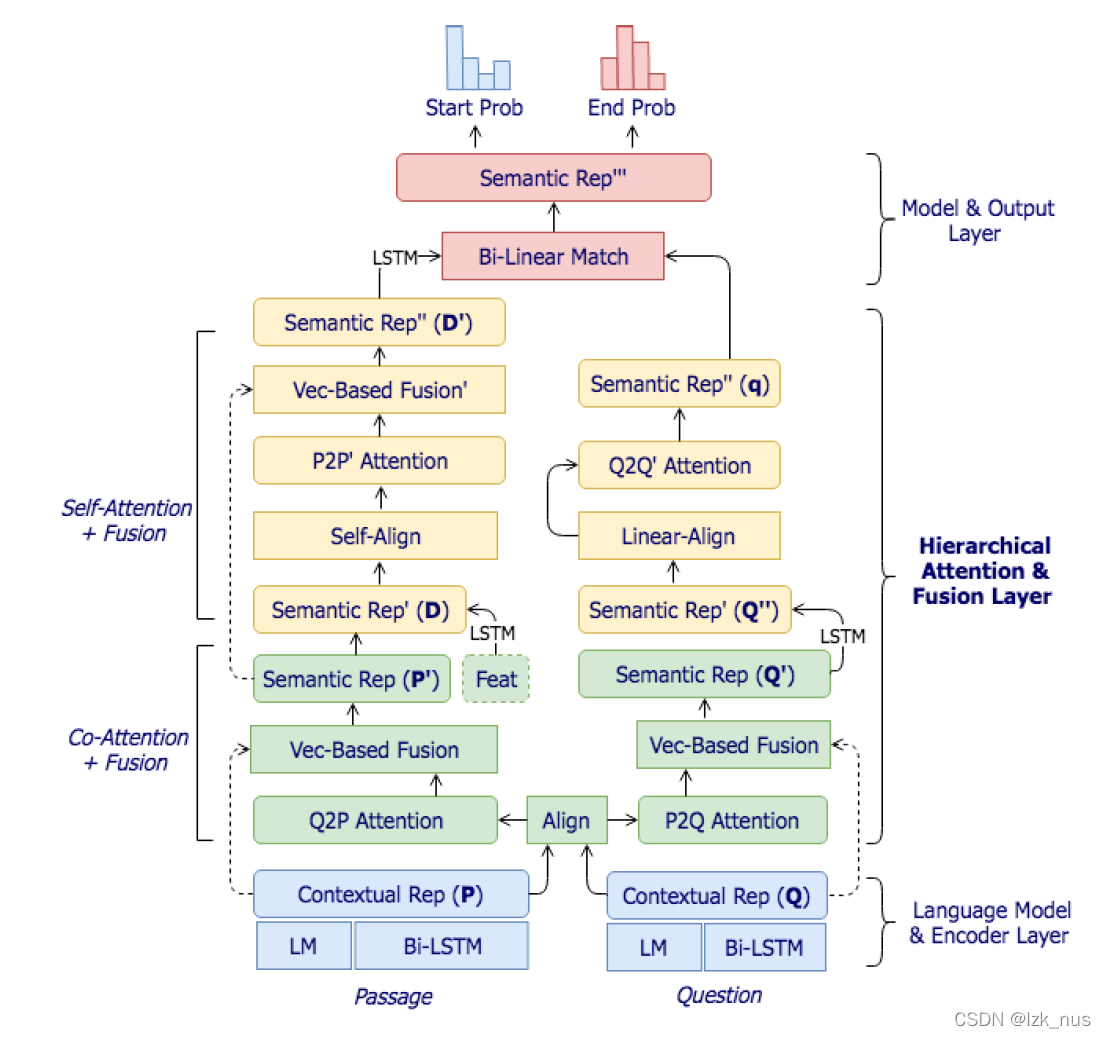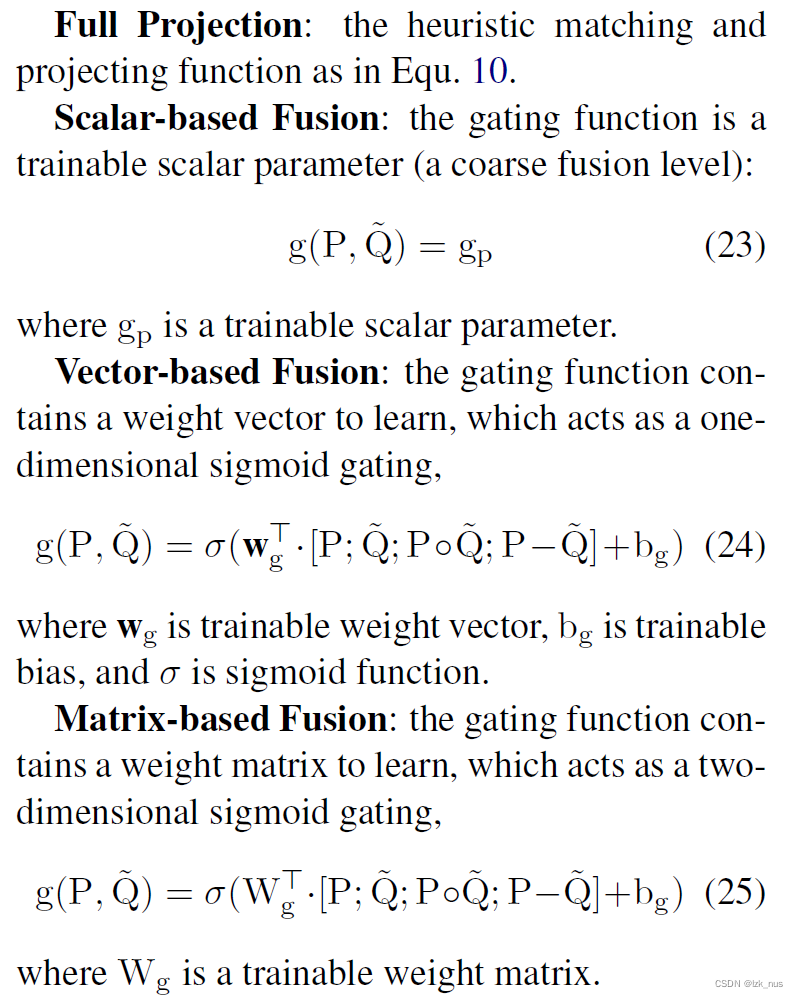Multi-Granularity Hierarchical Attention Fusion Networks for Reading Comprehension and Question Answering 论文笔记
这是阿里2018年发表在ACL上的一篇文章,创新性的使用了层级attention结构,并加入了fusion模块,在SQuAD数据集上取得了优异的表现。
Overview
作者的motivation来源于人类对阅读理解题目的处理:先浏览一遍文章和问题,然后把问题和文章进行联系,接着把答案的大体区间确定下来(这个在雅思阅读里叫定位),最终再次回顾文章和问题(这个在雅思阅读里叫精读)选取出最优答案。从这样的一种模式中作者捕捉到了一种分层理解结构,即文章与问题之间的联系和对文章、问题分别进行深度理解。因此本文核心的部分就是Hierarchical Attention Fusion Network:
- a basic co-attention layer with shallow semantic fusion
- a self-attention layer with deep semantic fusion
- a memory-wise bilinear alignment function
作者也称这种attention机制所学习到的特征是多细粒度的(multi-granularity),通过这种一层一层的attention机制逐渐定位答案。同时,作者对attention function和fusion kernel的改进也对模型效果的提升做出了很大贡献。
Model Architecture
模型大致分为四个部分:
- Embedding & Encoder
- Co-Attention & Fusion
- Self-Attention & Fusion
- Model & Output(the third layer of attention)

其中,第二、第三和第四中的Model部分共同组成了本文的hierarchical结构。上图就是模型的总体架构,应该来说,这个模型是相对比较复杂的。
Embedding & Encoder
本文一大亮点在于embedding部分,作者依然是word+character embedding,word是Glove,但是character采用的是ELMo,后面的消融实验也证明了ELMo的效果的确是好。得到word embedding
e
e
e和 char embedding
c
c
c后,将它们concatenate起来输入到一个Bi-LSTM中,最终,我们把Bi-LSTM的输出与char embedding拼接起来作为Encoder的输出。
u
t
P
?
=
?
[
B
i
L
S
T
M
(
[
e
t
P
;
c
t
P
]
)
;
c
t
P
]
u
t
Q
?
=
?
[
B
i
L
S
T
M
(
[
e
t
Q
;
c
t
Q
]
)
;
c
t
Q
]
P
=
{
u
t
P
}
t
=
1
n
?????
Q
=
{
u
t
Q
}
t
=
1
m
u^{P}_{t}\ =\ [BiLSTM([e^{P}_{t};c^{P}_{t}]);c^{P}_{t}]\\ u^{Q}_{t}\ =\ [BiLSTM([e^{Q}_{t};c^{Q}_{t}]);c^{Q}_{t}] \\ P=\{u^{P}_{t}\}_{t=1}^{n} \ \ \ \ \ Q=\{u^{Q}_{t}\}_{t=1}^{m}
utP??=?[BiLSTM([etP?;ctP?]);ctP?]utQ??=?[BiLSTM([etQ?;ctQ?]);ctQ?]P={utP?}t=1n??????Q={utQ?}t=1m?
Co-Attention & Fusion
这一部分计算的是passage与query之间的关系,简单来说就是P2Q和Q2P的双向attention外加一个fusion,这里的fusion是一个创新点。similarity score的计算方式作者也进行了一些改进:
S
i
j
=
A
t
t
n
(
u
i
P
,
u
j
Q
)
=
R
e
L
u
(
W
T
u
i
P
)
?
R
e
L
u
(
W
T
u
j
Q
)
S_{ij} = Attn(u^{P}_{i},u^{Q}_{j})=ReLu(W^{T}u^{P}_{i})\cdot ReLu(W^{T}u^{Q}_{j})
Sij?=Attn(uiP?,ujQ?)=ReLu(WTuiP?)?ReLu(WTujQ?)
改进的原因我引用作者原话:This decomposition avoids the quadratic complexity that is trivially parallelizable.
然后P2Q和Q2P的attention就是分别对row和col进行softmax
α
i
?
=
?
s
o
f
t
m
a
x
(
S
i
:
)
Q
^
?
=
?
∑
i
=
1
m
α
i
Q
i
\alpha_{i} \ = \ softmax(S_{i:})\\ \hat{Q} \ =\ \sum_{i=1}^{m} \alpha_{i}Q_{i}
αi??=?softmax(Si:?)Q^??=?i=1∑m?αi?Qi?
β j ? = ? s o f t m a x ( S : j ) P ^ ? = ? ∑ j = 1 n β j P j \beta_{j} \ = \ softmax(S_{:j})\\ \hat{P} \ =\ \sum_{j=1}^{n}\beta_{j}P_{j} βj??=?softmax(S:j?)P^?=?j=1∑n?βj?Pj?
接下来是fusion,作者分别将
P
P
P与
Q
^
\hat{Q}
Q^?融合,
Q
Q
Q与
P
^
\hat{P}
P^融合
P
′
?
=
?
F
u
s
e
(
P
,
Q
^
)
Q
′
?
=
?
F
u
s
e
(
Q
,
P
^
)
P' \ =\ Fuse(P,\hat{Q})\\ Q' \ =\ Fuse(Q, \hat{P})
P′?=?Fuse(P,Q^?)Q′?=?Fuse(Q,P^)
融合的kernel选择有很多,比如简单的concat,文中采用的是带有difference和element-wise product的融合
m
(
p
,
q
)
?
=
?
t
a
n
h
(
W
f
[
p
;
q
;
p
°
q
;
p
?
q
]
)
m(p, q)\ =\ tanh(W_{f}[p;q;p \circ q; p - q])
m(p,q)?=?tanh(Wf?[p;q;p°q;p?q])
接下来,作者又认为Encoder得到的original的contextual embedding学习了passage与query的全局信息,因此又通过gate将original embedding与fusion feature进行拼接,类似于highway,最终得到的passage、query表示分别为:
P
′
?
=
?
g
(
P
,
Q
^
)
?
m
(
P
,
Q
^
)
+
(
1
?
g
(
P
,
Q
^
)
)
?
P
Q
′
?
=
?
g
(
Q
,
P
^
)
?
m
(
Q
,
P
^
)
+
(
1
?
g
(
Q
,
P
^
)
)
?
Q
P' \ =\ g(P, \hat{Q}) \cdot m(P,\hat{Q}) + (1-g(P,\hat{Q})) \cdot P\\ Q' \ =\ g(Q, \hat{P}) \cdot m(Q,\hat{P}) + (1-g(Q,\hat{P})) \cdot Q
P′?=?g(P,Q^?)?m(P,Q^?)+(1?g(P,Q^?))?PQ′?=?g(Q,P^)?m(Q,P^)+(1?g(Q,P^))?Q
P
′
P'
P′可以看作是query-aware的passage representation,
Q
′
Q'
Q′可以看作是passage-aware的query representation。后面实验部分作者还对比了不同fusion kernel带来的效果差异


Self-Attention & Fusion
接下来是self-attention的部分,和R-Net的想法一样,作者希望通过self-matching的方法将passage、query对的representation分别进一步增强,学习到一些内在联系。
Passage part
一开始,作者先采用了一个小trick,他把人工特征加入到passage的表示中,也就是现在的passage representation变成了
[
P
′
;
f
e
a
t
m
a
n
]
[P';feat_{man}]
[P′;featman?],然后在把它传到一个Bi-LSTM中得到
D
D
D
D
?
=
?
B
i
L
S
T
M
(
[
P
′
;
f
e
a
t
m
a
n
]
)
D \ =\ BiLSTM([P';feat_{man}])
D?=?BiLSTM([P′;featman?])
虽然叫做self-attention,但作者采用的attention计算方式不是attention is all you need,而是一种bilinear的self-alignment,其实也就是我理解的multiplicative
L
?
=
?
s
o
f
t
m
a
x
(
D
?
W
l
?
D
T
)
D
^
?
=
?
L
?
D
L \ =\ softmax(D \cdot W_{l} \cdot D^{T})\\ \hat{D}\ =\ L \cdot D
L?=?softmax(D?Wl??DT)D^?=?L?D
然后又是fusion,
D
′
?
=
?
F
u
s
e
(
D
,
D
^
)
D'\ =\ Fuse(D,\hat{D})
D′?=?Fuse(D,D^),再把fuse后的
D
′
D'
D′传到一个Bi-LSTM中得到这一层里passage的最终表示
D
′
′
?
=
?
B
i
L
S
T
M
(
D
′
)
D'' \ =\ BiLSTM(D')
D′′?=?BiLSTM(D′)
Query part
query的self-alignment与passage有些不同,首先还是将
Q
′
Q'
Q′传入到一个BiLSTM中得到
Q
′
′
Q''
Q′′,然后attention的计算不再是bilinear的,而是简单的linear
γ
?
=
?
s
o
f
t
m
a
x
(
w
q
T
Q
′
′
)
q
?
=
?
∑
i
=
1
m
γ
i
Q
i
′
′
\gamma\ =\ softmax(w^{T}_{q}Q'')\\ q\ =\ \sum_{i=1}^{m}\gamma_{i}Q''_{i}
γ?=?softmax(wqT?Q′′)q?=?i=1∑m?γi?Qi′′?
这样得到的query的最终表示变成了一个向量
Model & Output
输出层文章说的是采用了Pointer-Net,但是实际上并不是Pointer-Net的形式,作者在输出的部分又做了一次bilinear的alignment,然后得到start和end的概率分布
p
s
?
=
?
s
o
f
t
m
a
x
(
q
?
W
s
T
?
D
′
′
)
p
e
?
=
?
s
o
f
t
m
a
x
(
q
?
W
e
T
?
D
′
′
)
p_s \ = \ softmax(q \cdot W^{T}_{s} \cdot D'')\\ p_e \ = \ softmax(q \cdot W^{T}_{e} \cdot D'')
ps??=?softmax(q?WsT??D′′)pe??=?softmax(q?WeT??D′′)
Experiment & Analysis
在SQuAD数据集上的指标

成功成为了新SOTA,然后是鲁棒性测试

也成功超过了其他所有模型。我们重点来看消融实验和对比试验
Ablation

从表格中我们可以看出来,ELMo对模型效果的贡献度相当之高,同时bilinear match也在模型中扮演了非常重要的角色。但我对这个实验有一点异议,我认为对于bilinear match这个部分不应该做消融,毕竟把它消融掉就没有attention了,那效果肯定拉跨。后面的对比试验是正确的
Comparison

可以看到这里作者做了两个对比:
- 不同层级的attention
- attention function选取
这个对比实验证明了本文的三层hierarchical attention效果是最佳的,并且bilinear attention也是效果最好的。
Reflection
这篇文章我最大的感觉是整体架构与R-Net很像,虽然作者并没有说他们借鉴了R-Net,但是我感觉两者有异曲同工之妙,都采用了这种Embedding - Co-Attention - Self-Matching - Model - Output的架构。实验数据也证明了我的猜想,可以看到R-Net与SLQA之间差距甚微,个人感觉大概率是这个ELMo拉开的差距,当然还有这个fusion加highway也起到了不少作用。本文在最后在输出答案的阶段再对passage和query做了一次alignment是一个创新点,普通的pointer network会直接将两者的向量表示拼接然后传入语言模型,但是这里再通过一个bilinear attention取得了更好的效果。
总的来说这篇文章很系统的总结出了基于MRC的QA模型架构,不同的模型只是在这个架构的某几个部分进行改进。